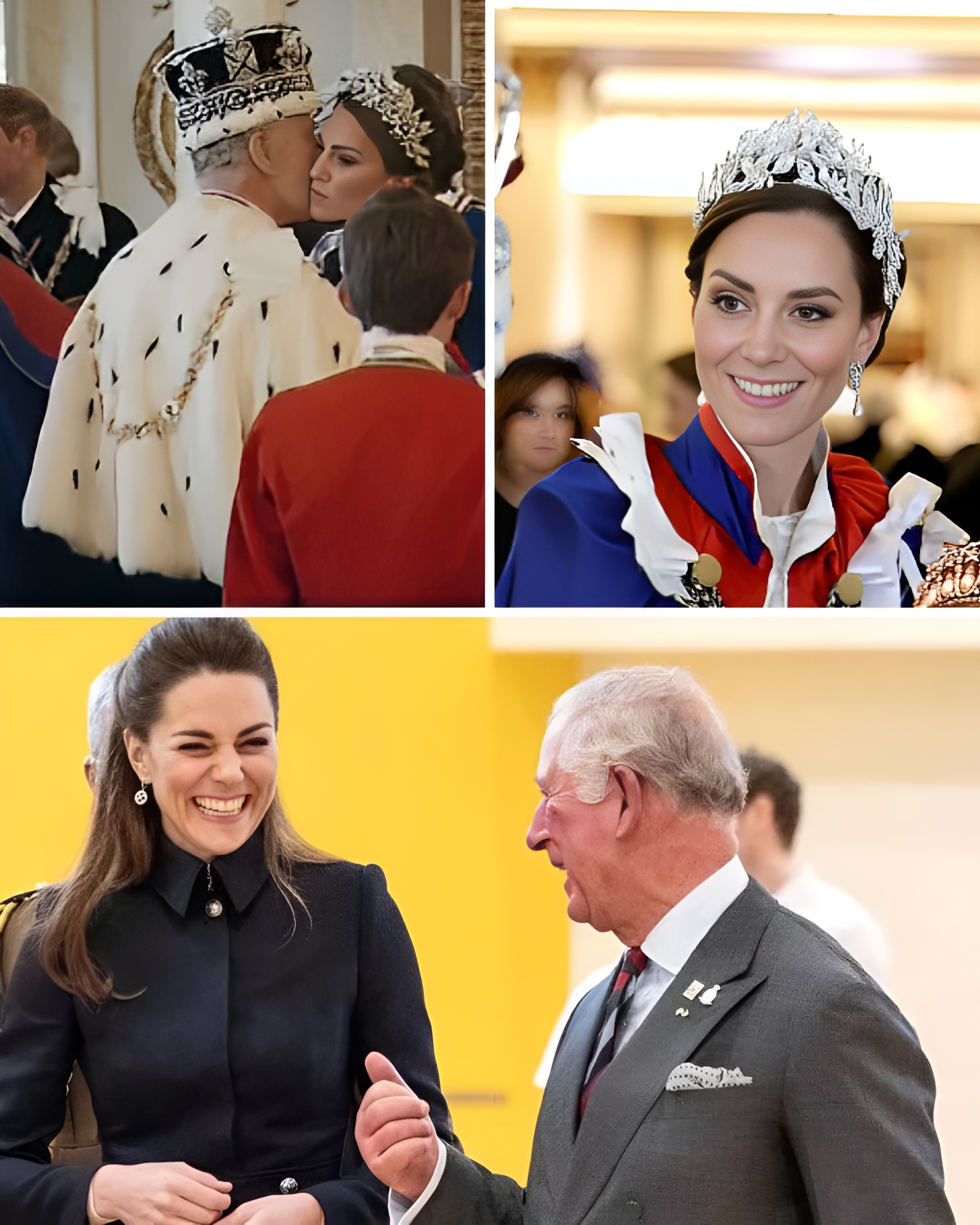
In a moment that left the grand dining hall of Windsor Castle breathless and a nation misty-eyed, King Charles III broke centuries of royal convention with a deeply personal and profoundly moving tribute to his daughter-in-law, Princess Catherine. His words, soft but unmistakably powerful, echoed through the gilded walls of the historic State Banquet — a moment that would transcend diplomacy and become one of the most talked-about royal speeches in recent memory.
The banquet, held in honor of French President Emmanuel Macron and First Lady Brigitte Macron, was meant to celebrate the enduring bonds of Anglo-French relations. But by the end of the evening, it had become something much more: a global symbol of resilience, familial love, and a new era of emotional transparency within the British monarchy.
A Break in Tradition, A Bond Beyond Blood
As the evening unfolded with its usual pageantry — polished silverware, candlelit chandeliers, and the harmonious notes of classical music — no one could have predicted the emotional turn it would take. Toward the end of his formal toast, King Charles paused. The room fell silent.
He looked toward Princess Catherine, seated alongside Prince William, and said simply, with deliberate clarity:
“I’m proud of you, daughter.”
Those seven words were more than just a personal sentiment. They broke the unspoken emotional restraint so often associated with the Royal Family. For a king known for his devotion to duty and measured tone, this was a rare window into his heart — a heartfelt acknowledgment not just of Catherine’s royal role, but of her extraordinary strength in the face of private suffering.
Within hours, the phrase had gone viral, splashed across headlines and lighting up social media feeds. Hashtags like #ProudOfYouDaughter, #CatherineTheBrave, and #RoyalsWithHeart surged across platforms, capturing the emotional weight of the moment.
Two Diagnoses, One Unbreakable Connection
The speech struck an even deeper chord given the shared circumstances between the King and the Princess of Wales. Just months earlier, the world had learned that both Charles and Catherine were facing private battles with cancer — a rare and sobering parallel in their lives.
In January, Princess Catherine underwent abdominal surgery. Later, in a deeply personal video message released in March, she revealed that post-operative tests had found cancer, and she was now undergoing preventative chemotherapy. Her words, spoken with calm resolve and compassion, inspired countless people around the world.
Around the same time, Buckingham Palace confirmed that King Charles had also been diagnosed with cancer and had begun treatment. The palace stated that he had been in “the closest contact” with Catherine throughout, expressing his “immense pride in her courage and clarity.”
This quiet, shared struggle had forged a bond between the monarch and his daughter-in-law that reached beyond titles and ceremony — a king and a future queen consort, yes, but more deeply, two individuals navigating the uncertain path of illness with dignity and grace. The King’s words that night were not just ceremonial. They were human. They were healing.
From Windsor, With Love
In his address, Charles also reflected warmly on William and Catherine’s choice to raise their family at Adelaide Cottage, nestled within the Windsor estate. He spoke of the couple’s desire to give their children — Prince George, Princess Charlotte, and Prince Louis — a life of balance, rooted in both tradition and normalcy.
Drawing a gentle historical parallel, the King noted that Windsor Castle was first established by William the Conqueror as a symbol of strength and legacy. Today, that legacy lives on not just in stone and crown, but in the small, everyday moments of family life in Adelaide Cottage — bedtime stories, morning walks, laughter, and love.
The Nation Responds
Public reaction was immediate and deeply emotional. Social media flooded with messages of support, admiration, and collective healing. Citizens from across the UK and around the world posted personal stories of their own battles with cancer, expressing how the royal family’s openness had given them strength and hope.
“It felt like watching a father embrace his daughter — not with arms, but with words,” one royal commentator wrote. “In that moment, he wasn’t King Charles. He was simply a proud parent.”
For many, the tribute represented a changing tide — a monarchy slowly evolving from rigid tradition to something more human, more relatable, and more in step with the emotional honesty of the 21st century.
A Toast, A Turning Point
In a family often associated with emotional reserve and carefully managed public personas, King Charles’ heartfelt tribute marked a quiet but unmistakable revolution. It wasn’t just a royal toast. It was a benediction — a moment of raw humanity from a monarch and father figure who has weathered a lifetime in the public eye.
For Catherine, who has gracefully balanced the immense weight of royal duties with her role as a mother and her fight against illness, the King’s words offered a rare public affirmation — and an outpouring of national gratitude followed.
The future Queen has long been admired for her poise, elegance, and quiet strength. But now, she is being celebrated for something far more profound: her vulnerability, her courage, and the way she has carried her pain with dignity and grace.
A New Royal Era
In an age when the monarchy is under increasing pressure to modernize, connect, and humanize, moments like these matter. They reveal the beating heart beneath the crown — the people behind the protocol.
“We are all healing. Together,” King Charles said in closing — a simple sentence that landed with the weight of history behind it.
Perhaps that is the legacy of this moment: a new vision of monarchy, not defined by distance and grandeur, but by unity, empathy, and shared humanity.
